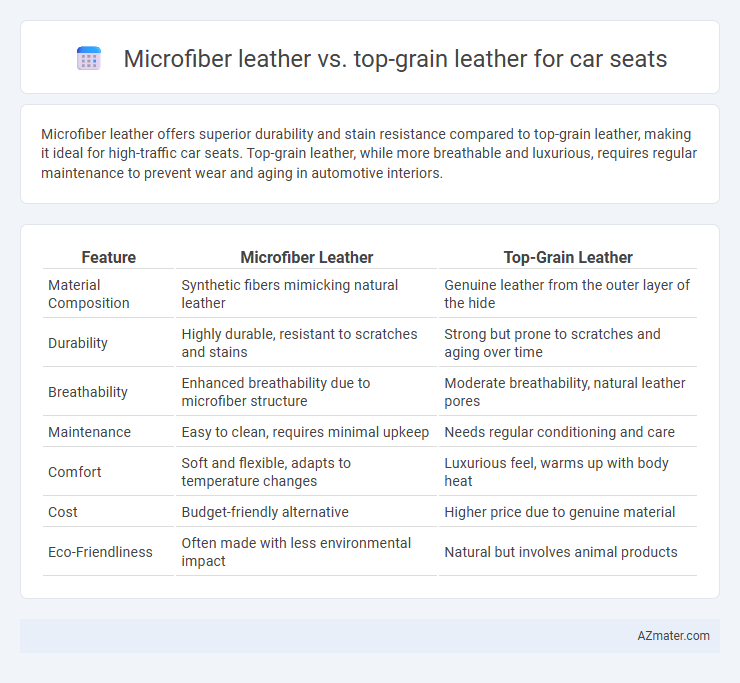Microfiber leather offers superior durability and stain resistance compared to top-grain leather, making it ideal for high-traffic car seats. Top-grain leather, while more breathable and luxurious, requires regular maintenance to prevent wear and aging in automotive interiors.
Table of Comparison
| Feature | Microfiber Leather | Top-Grain Leather |
|---|---|---|
| Material Composition | Synthetic fibers mimicking natural leather | Genuine leather from the outer layer of the hide |
| Durability | Highly durable, resistant to scratches and stains | Strong but prone to scratches and aging over time |
| Breathability | Enhanced breathability due to microfiber structure | Moderate breathability, natural leather pores |
| Maintenance | Easy to clean, requires minimal upkeep | Needs regular conditioning and care |
| Comfort | Soft and flexible, adapts to temperature changes | Luxurious feel, warms up with body heat |
| Cost | Budget-friendly alternative | Higher price due to genuine material |
| Eco-Friendliness | Often made with less environmental impact | Natural but involves animal products |
Introduction to Microfiber Leather and Top-Grain Leather
Microfiber leather, a synthetic material made from ultra-fine fibers, offers durability, water resistance, and easy maintenance, making it ideal for car seats exposed to frequent use and spills. Top-grain leather, crafted from the outermost layer of animal hide, is prized for its natural texture, breathability, and premium aesthetic, often found in luxury vehicles. The key differences between microfiber leather and top-grain leather lie in their composition, durability, and maintenance requirements, influencing comfort and longevity in automotive upholstery.
Material Composition and Manufacturing Process
Microfiber leather for car seats is composed of ultra-fine synthetic fibers, primarily polyurethane bonded onto a polyester base fabric, resulting in a durable, breathable material resistant to stains and wear. Top-grain leather, derived from the upper layer of animal hides, undergoes a thorough tanning and finishing process that preserves the natural grain while enhancing its softness and durability. The manufacturing of microfiber leather involves advanced synthetic fiber weaving and coating technologies, whereas top-grain leather requires precise animal hide selection, tanning, and surface finishing to achieve its premium texture and strength.
Durability and Longevity Comparison
Microfiber leather for car seats offers superior durability against scratches, stains, and UV damage compared to top-grain leather, making it ideal for high-traffic use. Top-grain leather provides excellent breathability and natural aging, but it requires regular maintenance to prevent cracking and wear over time. Overall, microfiber leather outperforms top-grain leather in longevity due to its enhanced resistance to environmental factors and lower maintenance needs.
Comfort and Aesthetic Appeal
Microfiber leather offers superior breathability and softness, enhancing comfort during long drives by reducing heat retention and moisture buildup in car seats. Top-grain leather provides a premium aesthetic appeal with its natural texture and durability, developing a unique patina over time that adds character. While microfiber leather excels in lightweight flexibility and stain resistance, top-grain leather remains the preferred choice for luxury interiors seeking authentic leather appearance and long-lasting elegance.
Breathability and Climate Adaptation
Microfiber leather offers superior breathability compared to top-grain leather, allowing better air circulation that helps reduce heat buildup and moisture accumulation inside car seats. Top-grain leather, while durable and luxurious, tends to trap heat and moisture more, making it less effective for climate adaptation in hot or humid conditions. Therefore, microfiber leather provides enhanced comfort in varied climates by maintaining a cooler and drier seating environment.
Maintenance and Cleaning Requirements
Microfiber leather offers superior stain resistance and requires minimal maintenance compared to top-grain leather, which needs regular conditioning and cleaning to prevent cracks and fading. Microfiber resists spills and dirt effectively, allowing for easy cleaning with mild soap and water, whereas top-grain leather demands specialized leather cleaners and conditioners to maintain its durability and appearance. Choosing microfiber leather reduces long-term care efforts and costs while preserving a fresh look in car seats.
Environmental Impact and Sustainability
Microfiber leather for car seats offers a more sustainable alternative to top-grain leather by reducing reliance on animal agriculture, which is a major source of greenhouse gas emissions and deforestation. Its production typically consumes less water and chemical treatments compared to traditional leather tanning, minimizing environmental pollution and resource depletion. While top-grain leather is durable and biodegradable, its environmental footprint is considerably higher due to the intensive livestock farming and tanning processes involved.
Cost Analysis: Microfiber vs Top-Grain Leather
Microfiber leather offers a more cost-effective solution for car seats compared to top-grain leather, with prices typically 30-50% lower due to its synthetic production process and lower material costs. Top-grain leather commands a premium price because of its natural durability, luxurious texture, and complex tanning process, often ranging between $15 to $25 per square foot. Considering long-term value, microfiber leather requires less maintenance and resists stains better, potentially reducing upkeep expenses over time.
Suitability for Different Car Models
Microfiber leather offers superior breathability and durability, making it ideal for economy and mid-range car models that require low maintenance and high comfort. Top-grain leather provides a luxurious feel and ages naturally, often favored in premium and luxury vehicles for its elegance and long-lasting quality. The choice between microfiber leather and top-grain leather depends on the car model's target market, with microfiber catering to practicality and longevity, while top-grain emphasizes sophistication and premium appeal.
Final Verdict: Which Leather is Best for Car Seats?
Microfiber leather offers superior durability, stain resistance, and easy maintenance, making it ideal for high-traffic car seats exposed to spills and wear. Top-grain leather provides a natural, breathable surface with luxurious texture and aging qualities, preferred for premium car interiors prioritizing comfort and aesthetics. For car seats combining longevity with cost-effectiveness, microfiber leather is the best choice, while top-grain leather suits those seeking elegance and natural feel.

Infographic: Microfiber leather vs Top-grain leather for Car seat
 azmater.com
azmater.com